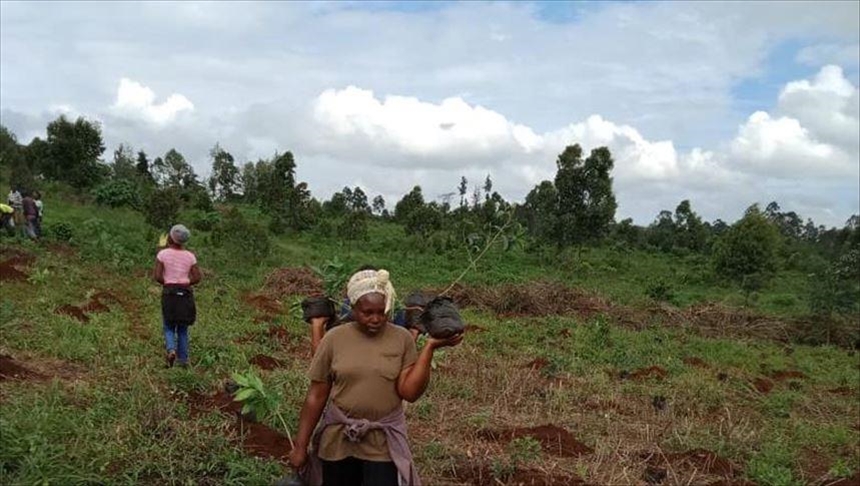Kenya’s reforestation efforts to mitigate climate change effects
Turkey among partners helping East African country to achieve target of 10% minimum tree cover by 2022
 FILE PHOTO
FILE PHOTO
NAIROBI, Kenya
Animal poaching, polluting water resources, deforestation, land sliding, and scanty rainfall are taking a heavy toll on the environment in the East African country of Kenya with a coastline on the Indian Ocean.
As the world observes World Environment Day on Saturday, Kenya, known for its wildlife like lions, elephants, and rhinos and safari visit to Maasai Mara Reserve, is inching towards realizing the goal of achieving 10% minimum forest cover by 2022 with the help of international partners.
Turkey is among the partners helping the reforestation of the country. In 2020 Turkish Ambassador Ahmet Cemil Miroglu inaugurated a special memorial forest in the capital Nairobi.
The July 15 Martyrs Memorial Forest, located in the Ngong Hills area on the outskirts of Kenya's capital Nairobi in memory of those killed on July 15, 2016, defeated coup in Turkey, has become a significant green area and attraction for people.
Kenyan President Uhuru Kenyatta said his government has identified forestry as a key sector of investment in the realization of the country’s development goal. However, despite this assurance, Kenya is experiencing numerous extreme weather conditions.
In a report released in May National Drought Management Authority said that during April, scanty rainfall was experienced in most parts of the arid and semi-arid lands. The counties such as Turkana, Marsabit, Garissa, Tana River, Kilifi, Lamu, Laikipia, and Nyeri (Kieni) received less than 50%of the average rainfall in April.
John Eyanae Ekal,56, and other residents of the Turkana area said they experience a similar situation every year.
“Growing up we have always had droughts, this year we are having a terrible drought, there is no food anywhere, pasture for our animals is dry and many animals are dying, communities are now living on food aid…but mostly wild fruits,” Ekal said.
He said the area which used to be full of trees has denuded over the years.
“We use them every day for firewood and charcoal. As a poor community, this is how we live. We rely on trees for fuel,” he said.
Drought situation
Due to COVID-19, the residents have received very little food aid as well.
John Bundotich project manager in World Vision International -- humanitarian aid, development, and advocacy organization – said in Turkana county as many as 185,000 people are affected by the drought situation and are facing acute water and food shortage.
Landslides that could have easily been avoided if deforestation was not rampant are becoming more common in other areas in Kenya.
In Ndau village in Makueni families are living in fear following perennial landslides that are sweeping away pit latrines, farm produces, livestock and sometimes leading to death.
“Over 20 houses have been destroyed, the affected are living in churches, most of them are living in terrible conditions, Nduu village is always facing this problem every year when it rains but it is worsening,” James Kavita, a resident, told Anadolu Agency.
In April 2020, 15 people, including women and children were killed and dozens of others went missing following a mudslide in the West Pokot and Elgeyo Marakwet counties.
Climate change is also affecting the country’s famed tea sector, a UK-based charity group Christian Aid said in a report.
“Livelihoods of many Kenyan tea producers could be in danger due to climate change. Kenya is the biggest exporter of black tea in the world so any drop off in production will have global consequences,” the report said.
Villagers earning carbon credits
In many areas, however, the government has of late setup projects to recover forest cover. The state-owned Kenya Forest Service has stepped up measures to preserve both its terrestrial and mangrove trees mostly by working with rangers and the communities that live beside the forests.
The government has introduced alternative fuel, deriving charcoal from mangroves to help the local population’s fuel needs and raise income by selling it. The rooting system of the mangroves can absorb more carbon than any other tree species in the coastal area, and are thus well equipped to fight climate change.
George Wara, an ecosystem conservator from the Kenya Forest Service said the community can earn some 1.5 million Kenyan shillings ($15,000) by selling carbon credits in international markets.
According to the UN Environment Program office in the capital Nairobi, carbon credits are tradable certificates that represent the reduction of one ton of carbon dioxide or the equivalent measurement of another greenhouse gas.
From the money they earn, the locals have started projects such as supplying books to schools, providing water for local communities, and creating employment opportunities for locals working in the forests.
Anadolu Agency website contains only a portion of the news stories offered to subscribers in the AA News Broadcasting System (HAS), and in summarized form. Please contact us for subscription options.





